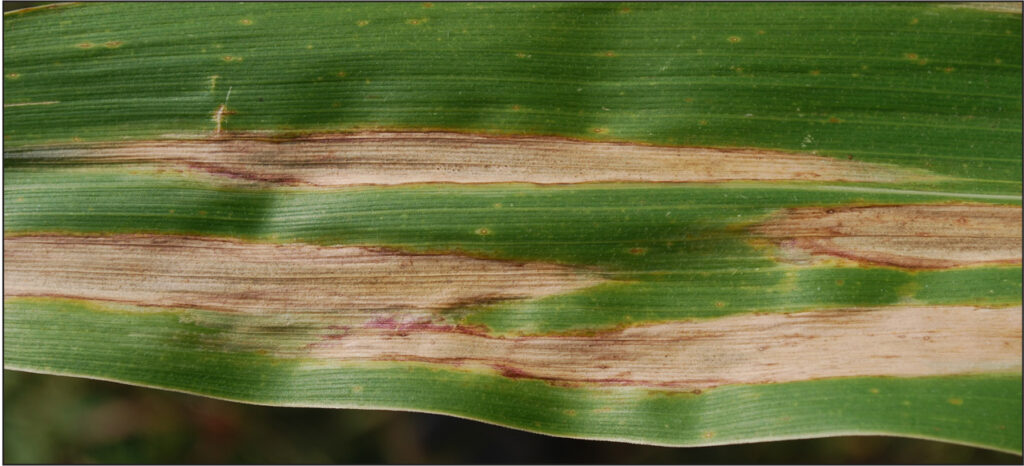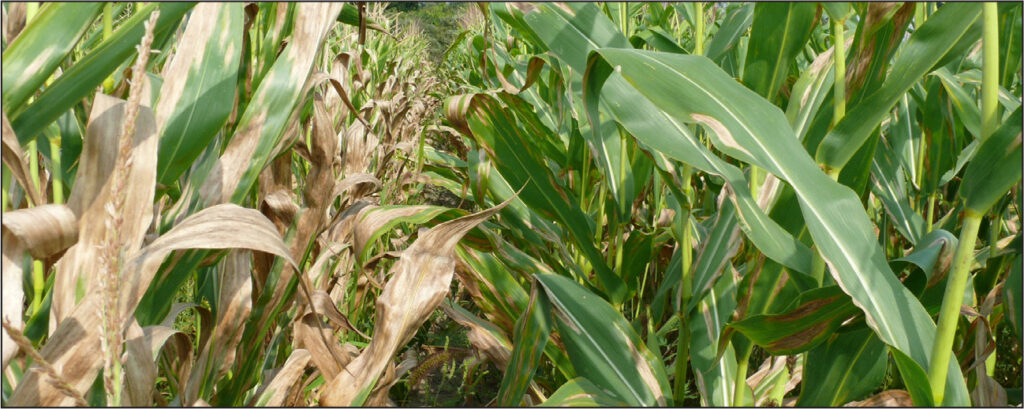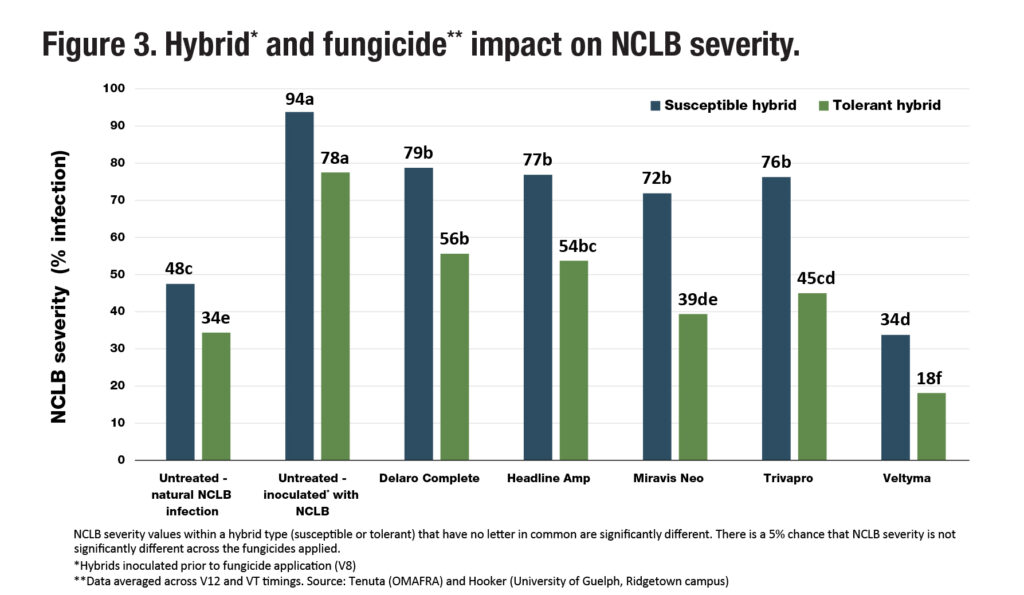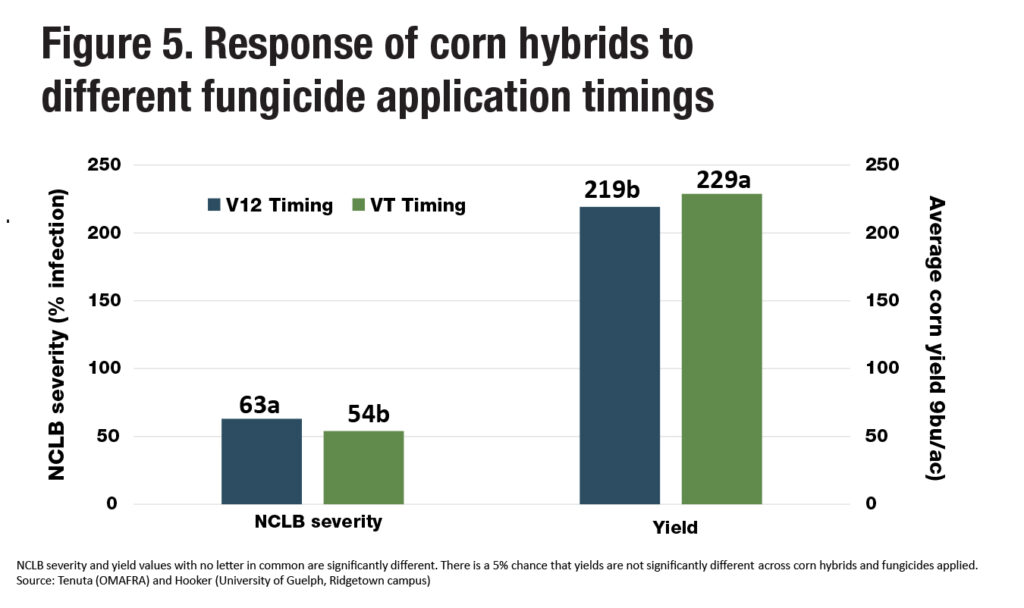More growers are noticing northern corn leaf blight (NCLB) – the most common corn leaf disease in Ontario. A proactive and integrated approach to management will mitigate significant financial losses.
The simple answer
Regular scouting is the best way to identify increases in the severity of NCLB. Ontario research has shown that an effective fungicide applied to an NCLB tolerant corn hybrid between tasseling (VT) and silking (R1) is the most effective way to decrease NCLB severity and protect grain yield potential. Reducing corn residue (<50% cover), rotating crop species (no corn after corn) and planting corn as early as possible will all contribute to reducing NCLB severity and increasing yields.

A little more information
Corn disease surveys conducted by OMAFRA (Ridgetown) and Agriculture and Agri-Food Canada (Ottawa) have noted an increase in NCLB severity and incidence across the province. This increase is due to several factors:
- More corn after corn production
- Increase in no till or reduced tillage (higher corn residue)
- Development of new NCLB races that are not controlled by resistant genes
- Intensive corn management strategies for yield (e.g. higher populations, higher rates of N) which can make conditions more favourable for disease
- Favourable environmental conditions (e.g. cool, wet)
Multi-season research OMAFRA (Ridgetown and University of Guelph Ridgetown Campus) has demonstrated that
planting a tolerant hybrid significantly reduces disease severity and increases corn yield (Figure 2). This research has also demonstrated that certain fungicides are effective at reducing NCLB infection. However, the greatest reductions
in NCLB severity and highest corn yields have occurred when an effective fungicide is applied to a NCLB tolerant hybrid at tasseling (VT).

The full story
The interaction of fungicides with NCLB resistant corn hybrids
Since 2019, inoculated NCLB field studies have evaluated the effectiveness of foliar fungicides at reducing NCLB infection and severity (% infection). Both susceptible and tolerant corn hybrids have been evaluated at different application timings (V12-14 vs. VT-R1). Planting hybrids that are tolerant to NCLB consistently reduced disease severity (Figure 3) and increased yield (Figure 4). When compared to untreated and inoculated corn hybrids, all fungicides significantly reduced disease severity (Figure 3) and increased yields (Figure 4). The largest reductions in disease severity and increases in corn yield occurred when a fungicide application was made to an NCLB tolerant hybrid. In 2021, one fungicide (Veltyma) was significantly better at reducing NCLB severity, resulting in significantly higher yields.


Disease severity and corn yield as affected by fungicide application timing
Most fungicides gave greater control of NCLB – resulting in higher corn yields – when applied between tasseling (VT) and silking (R1) compared to applying at late vegetative (V12) stages (Figure 5). The exception was Veltyma fungicide that was equally effective at both application timings (data not shown).

Summary of Best Management Practices
These six steps will help reduce NCLB risk and losses.
- Plant a high yielding corn hybrid with tolerance to NCLB.
- Avoid planting corn in successive years – rotate crop species.
- Limit corn residue levels to slow disease development.
- Plant early to avoid late season infection.
- Scout to identify disease levels and severity.
- Apply a foliar fungicide at tasseling, if necessary.
This research was supported in part by the Grain Farmers of Ontario who obtained funding through the AAFC Growing Forward and Canadian Agricultural Partnership with the Canadian Field Crop Research Alliance (CFCRA).
One thought on “Should I plan to apply a fungicide to control northern corn leaf blight?”
Comments are closed.